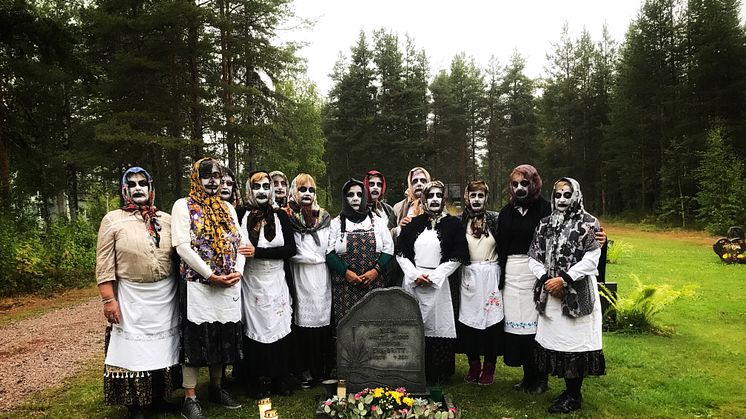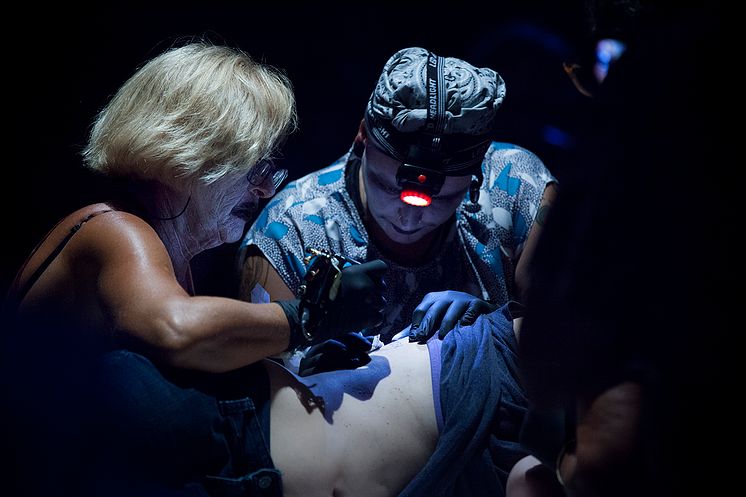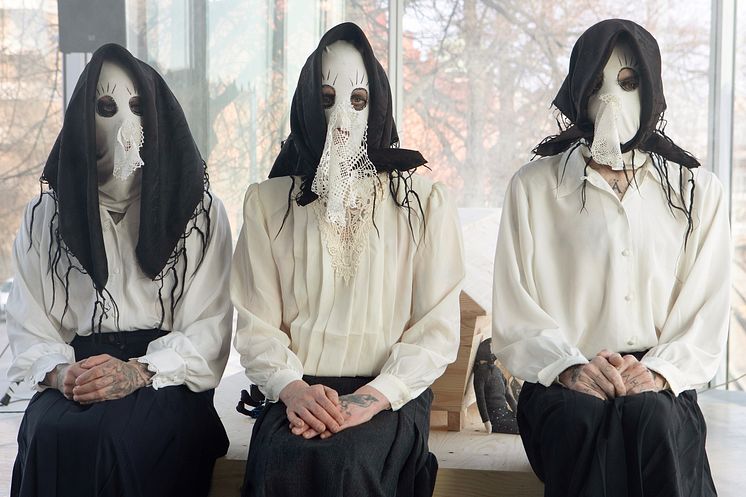
Pressmeddelande -
Bonniers Konsthall presents: Requiem for Eva-Britt / Markus Öhrn & Azdora
May 1–June 16
The Swedish director and artist Markus Öhrn has enjoyed great international success in recent decades with his award-winning stage works, which have led audiences to existential experiences along the margins of existence. Bonniers Konsthall is proud to present Markus Öhrn’s first major exhibition at an art institution. Requiem for Eva-Britt is a collaboration with the group Azdora, initiated in 2015 by Öhrn and its members in Italy. The exhibition marks the first time we get to see the extensive Azdora project in its entirety. It also presents a new ambitious performance work by Markus Öhrn. From a six-meter-high bell tower, the artist and invited guests hold death masses for visitors every Sunday. Requiem for Eva-Britt is about redress, for the artist’s grandmother Eva-Britt and other women – from the grave, across generations and in the present.
At his grandmother’s deathbed in the Torne Valley, Markus Öhrn asked her if there was anything she regretted – was there anything she would have done differently if she could live her life again? He was expecting an answer along the lines of a wish to have educated herself or travelled more. Instead, Eva-Britt replied that if she had the opportunity to do it all over again, she wished she had dared to be more destructive. That she would have dared to follow her own inner desires and not spent her whole life just being there for others – as a good mother, grandmother or wife. ”I wish I had dared to do something really stupid, something for myself, just once,” she said.
The exhibition Requiem for Eva-Britt is a sanctification of Eva-Britt’s words, and the fruit of a nearly ten-year collaboration between Markus Öhrn and Azdora – a group of 13 elderly women from the Emilia Romagna region in northern Italy. In this exhibition, visitors are presented with the Azdora project in its entirety for the first time since the group was formed at the Santarcangelo Festival in 2015. Since then, the group has, in more or less organized forms, smashed washing machines, cars and groceries, tattooed people, travelled the world and released a vinyl album that has become iconic in black metal circles. Markus Öhrn’s work is often about power shifts, or about creating power out of powerless roles. He often examines and returns to patriarchal structures or societal constraints, but also to a kind of wild and brutal liberation, especially for the female protagonists in his works.
The Azdora project differs from Öhrn’s stage works in that it is performative without being staged. The means of fiction are used as an aid, but the effects of the project find their way into reality. By radically addressing their self-representation, in the form of clothing, makeup and altered behaviors, and at the same time entering the project with their own experiences and stories, the Azdoras enter into roles. Through clothes and attitudes, they combine Öhrn’s artistic imagination with their own fantasies and desires. The subordinate becomes the powerful, where something dark, playful, luminous, brutal and heartfelt emerges.
This work has fundamentally changed me and what my artistic practice is. Sure, I can experience euphoria in other projects, a kick in the moment, but this work is a building block in the foundation that no one can take away. It is the most important work I have done and will ever do. - Markus Öhrn
The heart of the exhibition is a large newly produced work in the form of a six-meter high timbered black bell tower in the main exhibition space of Bonniers Konsthall. Several times per hour, the bell in the stack rings for the work’s protagonist Eva-Britt. On Sundays, Markus Öhrn and his invited guests give performances in the form of death masses at the top of the tower. Each death mass has a special place in Markus and Eva-Britt’s relationship and becomes the artist’s personal tribute and redress of a person who has played a crucial role in his life.
The exhibition ends with a final death mass where the Azdoras themselves are present at Bonniers Konsthall. Throughout the exhibition, visitors can apply to have the name of their own Azdora – an important, strong woman from an older generation – tattooed on their body. Ten of the applicants will be invited to the final death mass, where each will present their arguments as to why they deserve to have their azdora immortalized. The death mass ends with the winner being tattooed by the Azdoras.
In the world of Markus Öhrn and the Azdoras, the tropes of religion are mixed with elements of black metal, tattoo culture, splatter, smoke machines and emotional presence. The exhibition is about redress, for Eva-Britt and other women – from the grave, across generations and in the present. It is also about opening doors and seeing what happens.
In collaboration with:
Institutet
&
Italian Cultural Institute in Stockholm
For more information, please contact Head of Communications Kajsa Pontén: kajsa.ponten@bonnierskonsthall.se


